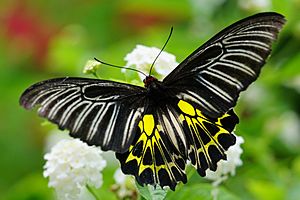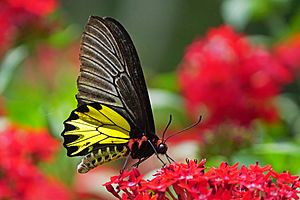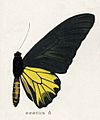Golden birdwing facts for kids
Quick facts for kids Golden birdwing |
|
|---|---|
 |
|
| Dorsal view | |
 |
|
| Ventral view | |
| Scientific classification | |
| Kingdom: | |
| Phylum: | |
| Class: | |
| Order: | |
| Family: | |
| Genus: |
Troides
|
| Species: |
T. aeacus
|
| Binomial name | |
| Troides aeacus C. & R. Felder, 1860
|
|
| Synonyms | |
|
|
The golden birdwing (Troides aeacus) is a very large and beautiful butterfly. It gets its name because of its huge size and bright golden colors. This amazing insect belongs to the Papilionidae family. You can find it in many parts of Asia, especially in countries like India, Nepal, China, and Thailand.
Contents
What is a Golden Birdwing?
The golden birdwing is one of the largest butterflies in the world. It is known for its impressive size. The females are usually bigger than the males. Their wings can spread out very wide.
Appearance of the Golden Birdwing
These butterflies have striking colors. The males often have bright yellow or golden hindwings. These wings have black veins and edges. Their forewings are usually dark, often black or brown. Females are generally less colorful. They have more black or dark brown on their wings. They might have some pale yellow or white spots. Both sexes have a fuzzy, dark body.
Where Golden Birdwings Live
Golden birdwings live in tropical and subtropical forests. They prefer areas with lots of trees and plants. They are found across a wide range in Asia. This includes Northeastern India, Nepal, Bangladesh, Myanmar, China, Thailand, Laos, Vietnam, Taiwan, Cambodia, peninsular Malaysia, and Indonesia. They often fly high up in the forest canopy. They also visit gardens and open areas to find flowers.
Life Cycle of the Golden Birdwing
Like all butterflies, the golden birdwing goes through a complete metamorphosis. This means it changes a lot during its life. It starts as an egg, then becomes a larva (caterpillar), then a pupa (chrysalis), and finally an adult butterfly.
Eggs and Larvae
The female golden birdwing lays her eggs on specific plants. These plants are usually from the Aristolochia genus. These plants are also called "pipevines." The eggs are small and round. Once the eggs hatch, tiny caterpillars emerge. These caterpillars eat the leaves of the pipevine plants. They grow quickly and shed their skin several times. The caterpillars are often dark-colored. They might have fleshy spines or bumps on their bodies.
Pupae and Adults
After growing enough, the caterpillar forms a pupa. This is a resting stage. The pupa often looks like a dried leaf or twig. This helps it hide from predators. Inside the pupa, the caterpillar transforms into a butterfly. This stage can last for several weeks. When the butterfly is ready, it breaks out of the pupa. The adult golden birdwing then emerges. It will soon fly off to find nectar and a mate.
Importance of Birdwing Butterflies
Birdwing butterflies are important for several reasons. They are part of the natural ecosystem. They also help us understand the health of our environment.
Pollination
Like many butterflies, golden birdwings help pollinate flowers. As they fly from flower to flower to drink nectar, they carry pollen. This helps plants reproduce. Pollination is vital for many plants, including those that produce our food.
Conservation Status
Many birdwing butterflies, including some types of golden birdwings, face threats. Their forest homes are sometimes destroyed. This is due to logging and farming. Collecting butterflies for sale can also be a problem. Because of these threats, many birdwings are protected by law. It is important to protect their habitats. This helps ensure these beautiful creatures can continue to fly.
Images for kids




